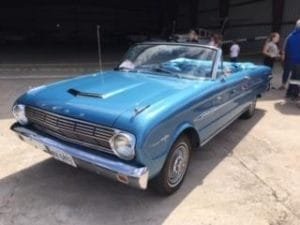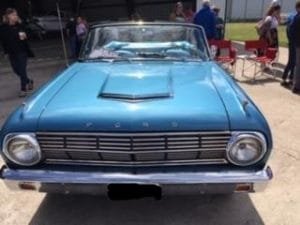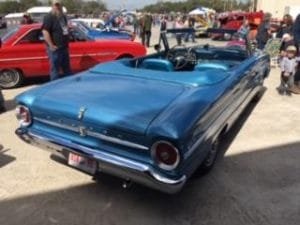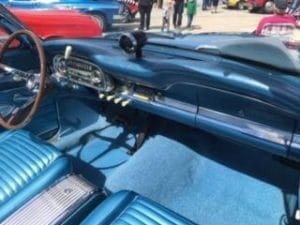Shown here is a beautiful 1963 Ford Falcon Sprint Convertible. The Falcon was a sales success for the Ford Motor Company, especially during it’s earlier years.

The Ford Falcon came out in September 1959 for the 1960 model year and was designated a compact. The Falcon was at the forefront of what would become American automakers effort to produce smaller and more economical cars. Performance of these new compact Falcons was a non starter but gas mileage was touted to be up to 30 MPG.
The first generation of Falcons ran from 1960 to 1963. Models covering the first generation included two and four door sedans and wagons plus the Ranchero Pick Up.
The Falcon Sprint
The Ford Falcon Sprint was a sportier model. The Sprint models came with special trim, bucket seats, console, simulated hood scoop, sport type steering wheel and a tachometer above the dashboard.
As it turned out, the Ford Falcon Sprint was the prelude to the 1964 1/2 Ford Mustang. The first Mustang’s were launched using the Falcon chassis.

The 1970 1/2 Ford Falcon was built on the Torino body frame and this model would be the last of the Falcons. There were three generations of the Falcon built in North America. Ford Australia would continue to produce the Ford Falcon until 2016 as a full size automobile.
The Origin of the Falcon Name
It’s also interesting to note that both Ford Motor and Chrysler decided to use the name “Falcon” at about the same time in the late 1950’s.
The story is that Ford was considering bird names for car models and came up with “Falcon”. Ford Motor Company notified the Automobile Manufacturers Association with their choice about twenty minutes before Chrysler while it’s said that Chrysler first approached the association with that same name earlier but failed to register it. Quite a coincidence.
1963 Ford Falcon Sprint Specifications
This lightweight automobile came out in 1960 with a 144 cubic inch straight six. For the 1963 model year a 260 cubic inch V-8 was made available along with a standard 170 cubic inch straight six. This was a small block 260 cubic inch engine putting out 164 HP. It’s interesting to note that the Falcon was the first of it’s compact category to offer a V-8.
Transmissions included a three and four speed manual along with a two speed automatic.
Brakes were four wheel hydraulic drums.
Dimensions include a 109.5 inch wheelbase, overall outside length 181.1 inches, width 70.6 inches.
 There were 10,479 Sprint Hardtops and 4,602 Sprint Convertibles produced for the 1963 model year. Total 1963 Ford Falcon Sedan production was 130,000 vehicles. Total Ford production for the 1963 model year was just under 2.2 million vehicles.
There were 10,479 Sprint Hardtops and 4,602 Sprint Convertibles produced for the 1963 model year. Total 1963 Ford Falcon Sedan production was 130,000 vehicles. Total Ford production for the 1963 model year was just under 2.2 million vehicles.
New car price for the 63 Falcon Spront Convertible was about $2,800 and about $2,000 for the Falcon Sedan.
Related Auto Museum Online articles are found on the links below…
Reference material for this article includes…The Ford Falcon, 1960-1963 by author P.K. Cottrill…Falcon Club of America...falconregistry.com..Ford Falcon Advertisements by Harry Ilaria.
1963 Ford Falcon Sprint Collector Cars\
The 1963 Ford Falcon Sprint Convertible is a very sporty looking automobile. The 1963-65 models are considered by many as being the more popular of the series and the collector interest covers both the hardtops and convertibles.
 As mentioned, the Falcon came out as a compact car but what was different was the performance. The 63 models were the first to have a 260 cubic inch V-8 which made a big difference.
As mentioned, the Falcon came out as a compact car but what was different was the performance. The 63 models were the first to have a 260 cubic inch V-8 which made a big difference.
The V-8 Falcons performed very well at Monte Carlo where eight Falcons were entered and eight finished.
Current asking prices for the 63 Sprint Convertible range from about $14,000 to $29,000. Falcon Sprint Hardtops are found at about $12,000 to $20,000. Values are based on age and degree of restoration, mileage, originality. The prices being asked for these popular models offers a relatively affordable way to begin a collection.
(Article and photos copyright Auto Museum Online)